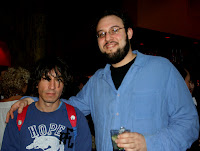 Noelie Giraud and Kim Massee
Noelie Giraud and Kim Massee
Young Pablo lives with his emotionally disconnected mother in a cheap Paris hotel. She takes off whenever she pleases, leaving her 11-year-old son to fend for himself among the cafés where mother and son are known only too well. When she deserts him once again, Pablo decides he’s had it. He convinces Louis, a down-on-his-luck poker player, to drive him to Spain to search for the man who could be his father. Kim Massee, an American raised in France, explores this relationship between two males searching for someone to belong to.
-Interview by Jon Robbins
Why the subject, why the project?
Kim Massee: About seven years ago, I directed a workshop in Paris with several actors, and Thierry was one of the participants. It took place in a Pigalle bar, and there were all these night owls at the bar. I wanted to develop a script from the improvised action, but in the end, I needed to make a film from it. And here I was, a new mother to a boy, writing a script about seedy men in Paris, it just seemed strange. So I eventually changed the project but kept Thierry’s character, because he had developed this character that was so real. I wanted to talk about what you learned when you had a child in your life, so I put Thierry’s character with a child.
Before you have kids, you think the transmission is from adult to child, that you’ll form the young person. But in fact it goes the other way. I kept learning things about myself from my son. And I wanted to talk about that and about a character so cut off from his feelings, going through life as this outcast trying to survive and not doing it well. He’s emotionally dead, and the child is suddenly thrown in his face, and reluctantly he travels with the kid, and it puts him back in touch with who he is. They’re mirror images of each other: the child is very much what this guy was like as a kid before life did to him whatever it did. And the child would become this man if not for that very man’s intervention. They’re both seeking something to look up to, and recognition, and they find it in each other in this odd way.
Is it true that the young actor in the film is your son?
Yes! I was very fortunate because I don’t believe in casting at all, I hate the whole process. Luckily, I know a lot of actors, but for a child it would have been more difficult had I not had one at home. The challenge was to get the production fast enough before my son became an adolescent. And I always write with actors in mind, so I wrote the lines according to how my son speaks.
And he was great! He spoke like a little gangster from the early Truffaut films.
I wanted him to be this weird kid who was brought up by all the mothers’ boyfriends, who was bringing himself up, really. He had these very out-of-date references, like his fantasy of having a pompadour. He likes cowboys and those Bob Dylan-ish songs! No French kid like that stuff.

Is the title from that Bob Dylan song that mentions ‘Cowboy Angels?’ [“The Gates of Eden”]
No, but I’d had even more references to Dylan in the film. In my dreams, I would have sent Bob Dylan the script and had him write a song for it, but I couldn’t afford a Bob Dylan song, so we wrote our own, "Blessing in Disguise," which is in the film. Laurent Petitgand composed the music and I did the lyrics. For the scene on the beach, Elliott Murphy performed it.
Did you know the young actor before doing the film?
Thierry: Yes.
Were you close?
Thierry: Not at first. As the film was shot in chronological order, we got to know each other a bit like our characters, over time.
And you had to throw him around a bit, didn’t you? Did his being the young son of the director make that more difficult?
Thierry: Not really, I mean, above all we were there to make a film. But in the beginning I was afraid because he was not acting out as his part required. And I told him ‘Who cares if your mom is the director,’ don’t think about it like that.’ That changed things.

Your character is emotionally dead to the world. Was it especially difficult, as someone whose job is so linked to emotional awareness, to play such a character?
Thierry: No.
Kim (to Thierry): In any case, you have them inside you. How you act them out, be it with gestures or words, it makes no difference.
Thierry: I’d love to make a film without dialogue. That thing I’d find most difficult to do, I would like to do.
Noelie and Thierry, in the film you two meet in a bar, and become for a short time, a couple, a mother and father for the boy…
Noelie: Kim and I are very close, and I think this allowed me to be close to Thierry and Diego in the film. And Kim was able to direct me so precisely because of our closeness. That’s what I think.
Kim: Noelie and Diego did know each other before the film, and they met in a special way, like children.
Noelie: When Diego learned he was going to be in the film with me, he started trying to bond with me. I would have dinner at their house, he would see me often, and there arose something warm between us. But Thierry and I didn’t know each other at all.
Thierry: We just slept together.
That helps.
Noelie: The love scene was the first we shot together.
Kim: And her boyfriend was there watching! And the 85-year-old proprietor of the hotel, who adored cinema, was watching as well, cane in tow. And we had to tell her, excuse us, but the actors would prefer some intimacy.
There is a special, ineffable, natural quality to the film…
Kim: This is always what you’re looking for, this special quality, at least I am always after it. This was one of the reasons we fell into making the film in chronological order, especially for my son, Diego.
Thierry: More for him, than us. We were able to live the film this way, and it’s better for a kid, than to have to shoot the ending first.
Kim: And by the end, there is a real rapport between Diego and Thierry. This really happened; even we took it as fact.
Noelie: For instance the scene on the beach.
Kim: I loved the beach. No need for words, everything is in how the boy is thrown into the water, how they hug one another, how they interact. The sea without words. We shot it in Les Landes. I’d taken Diego out of school a bit early, and the weather wasn’t so good, which made the scene even better.
What’s your next project?
Kim: I’m writing my next film with Thierry and Noelie in mind. It takes place in Brooklyn. It’s a story with three couples and they’re one of the couples. It’s about people and relationships.
It’s very new, this whole festival thing. I always push myself to expand my boundaries, to dare to look at new things. And I expect the same of my actors. When I get feedback like "oh, we’ve seen road films before,” I always think they’re missing the point. It’s not about that, but about how you explore the uniqueness of things, how you show them in a new light. It has to do with going to the core of things. When things are sort of naked, that, to me, is where you see the beauty.
(Interview translated from the French by Jon Robbins)





 -Jon Robbins
-Jon Robbins











































